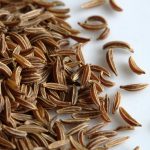 When a word is successively passed from one language to another, it not only may end up with a very different spelling and pronunciation, it may even refer to a different item than it originally did. For example, the Latin word for onion—caepa—became the English word chive, the name of a plant related to, but quite distinct from, the onion. Similarly, the Greek name for cumin became the English name for caraway. This Greek name—karon—was borrowed as alkarawiya by Arabic speakers, who still used it to refer to cumin; in the Middle Ages, however, European scholars adopted the Arabic form into Medieval Latin, and in the process transferred it to the similar-looking caraway seed and simplified its spelling to carvi. This new form then evolved into the Spanish caravea, which entered English as caraway in the mid fifteenth century.
When a word is successively passed from one language to another, it not only may end up with a very different spelling and pronunciation, it may even refer to a different item than it originally did. For example, the Latin word for onion—caepa—became the English word chive, the name of a plant related to, but quite distinct from, the onion. Similarly, the Greek name for cumin became the English name for caraway. This Greek name—karon—was borrowed as alkarawiya by Arabic speakers, who still used it to refer to cumin; in the Middle Ages, however, European scholars adopted the Arabic form into Medieval Latin, and in the process transferred it to the similar-looking caraway seed and simplified its spelling to carvi. This new form then evolved into the Spanish caravea, which entered English as caraway in the mid fifteenth century.
Annual or biennial herb with an aromatic, seed like fruit.
X is a fragrant herbaceous plant with delicate feathery verdant foliage and pale yellow-white blooms. The root of this herb, which is cooked similarly to a parsnip, has a mild and delicate flavor that is far from the sharpness of its piquant seeds. Similarly, the foliage, which is also milder compared to the seeds, has a comparable flavor and is employed in a variety of culinary dishes such as soups, salads, and vegetable dishes. The seeds, which are small and curved, possess a brownish hue and are either used whole or ground, serving as a flavor enhancer for bread varieties like rye bread, baked goods such as cakes and cookies, and savory dishes like vegetables, soups, and meats.
A plant that provides a crucial oil, commonly utilized as a carminative.
